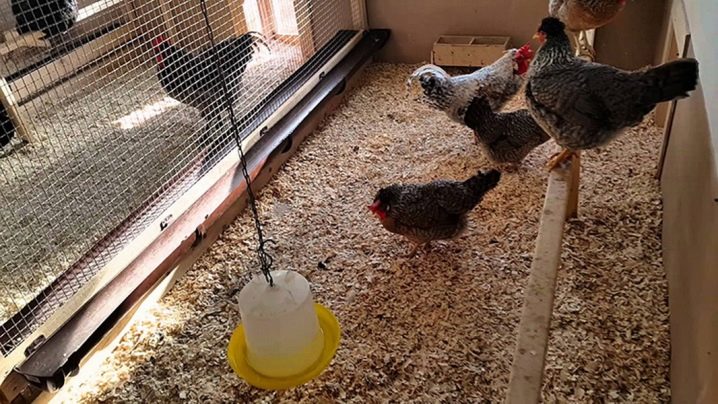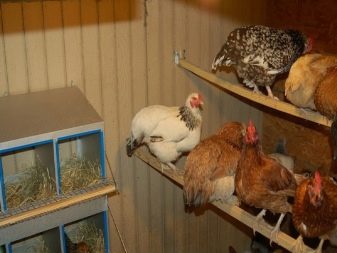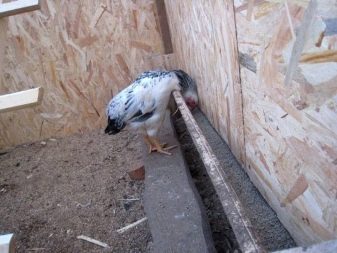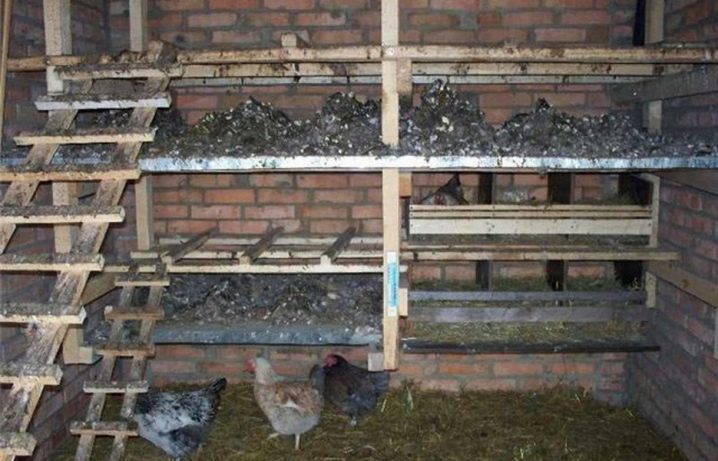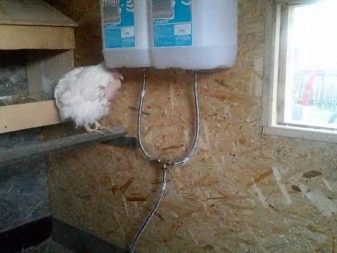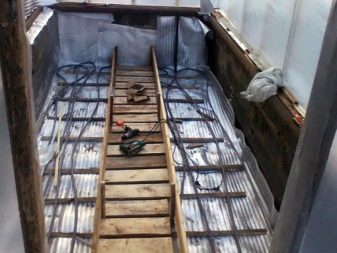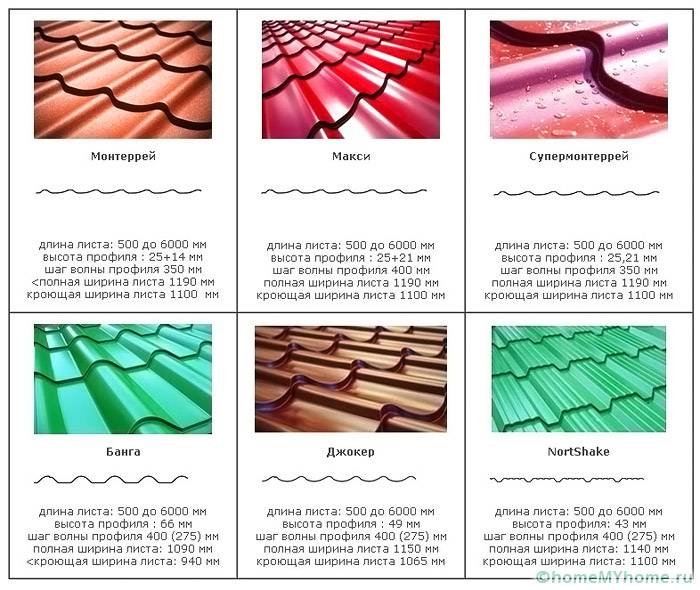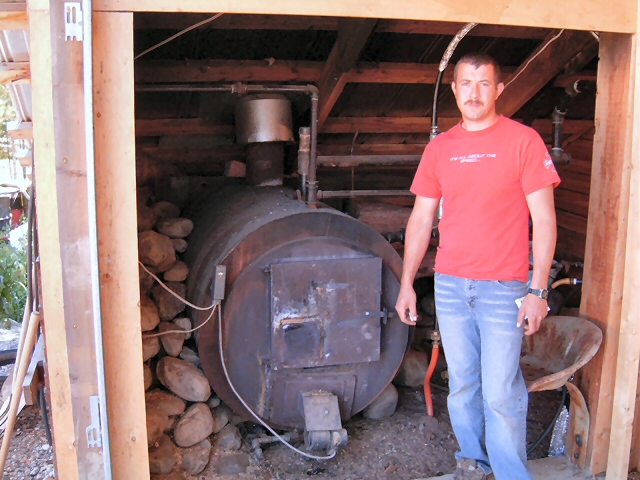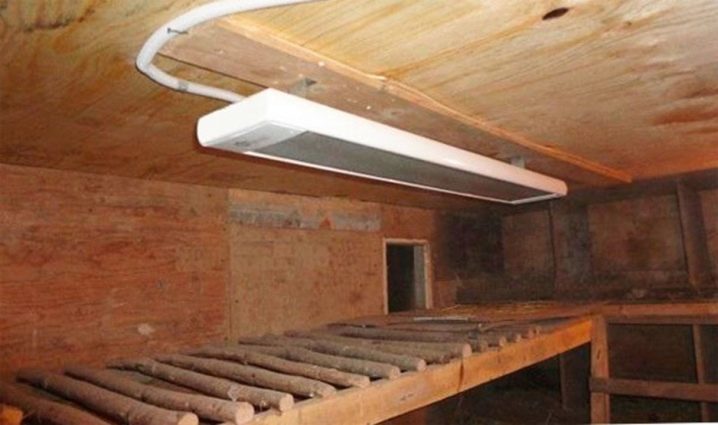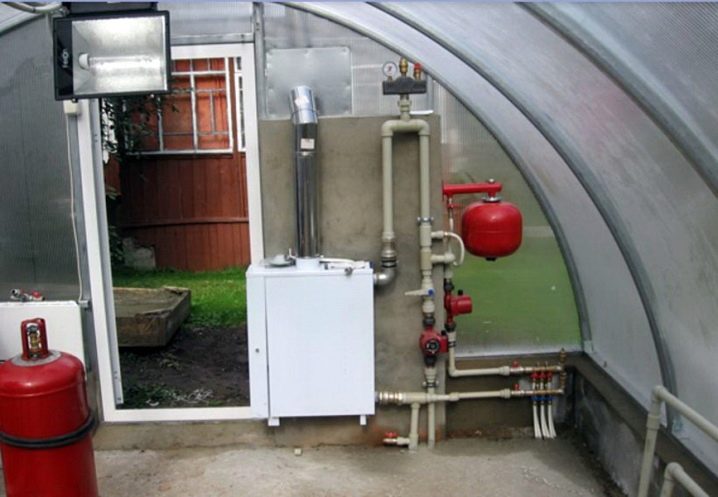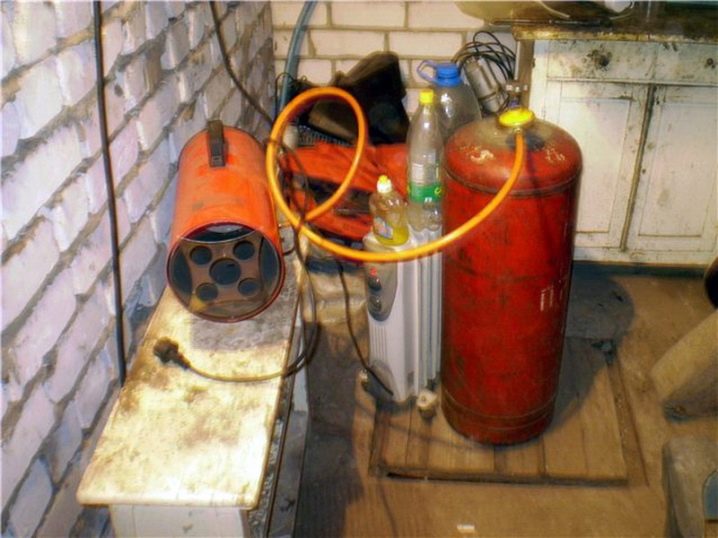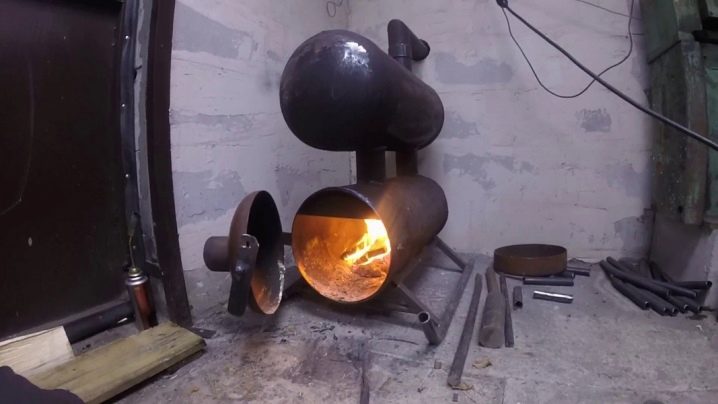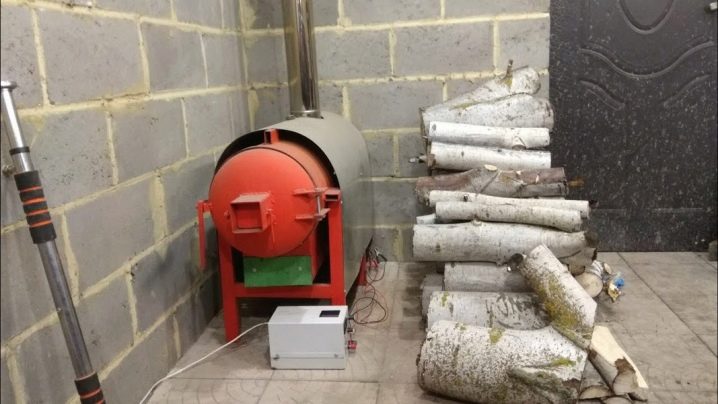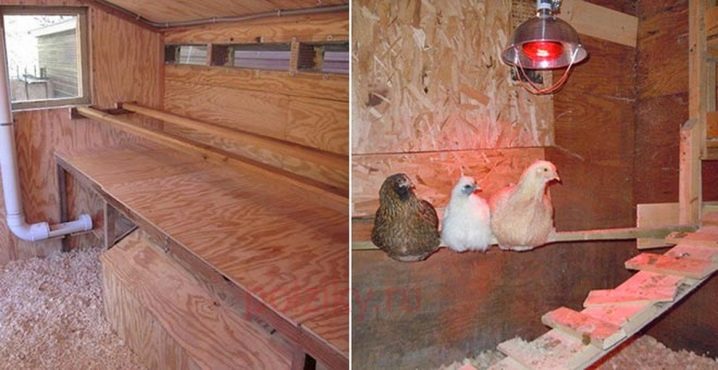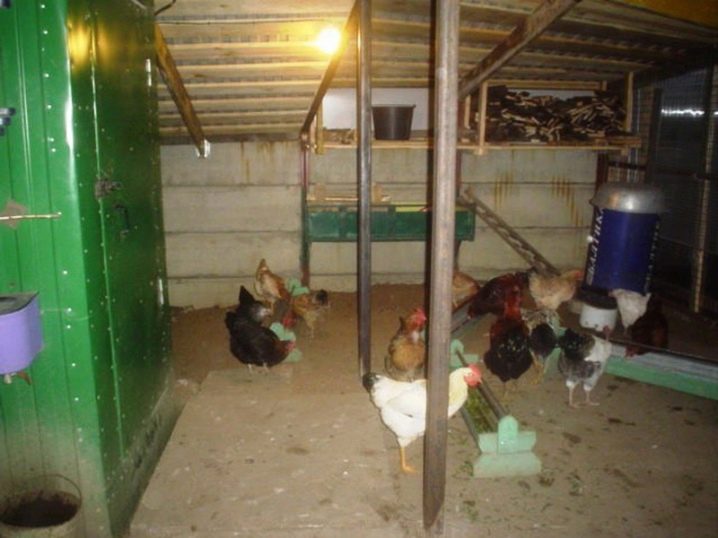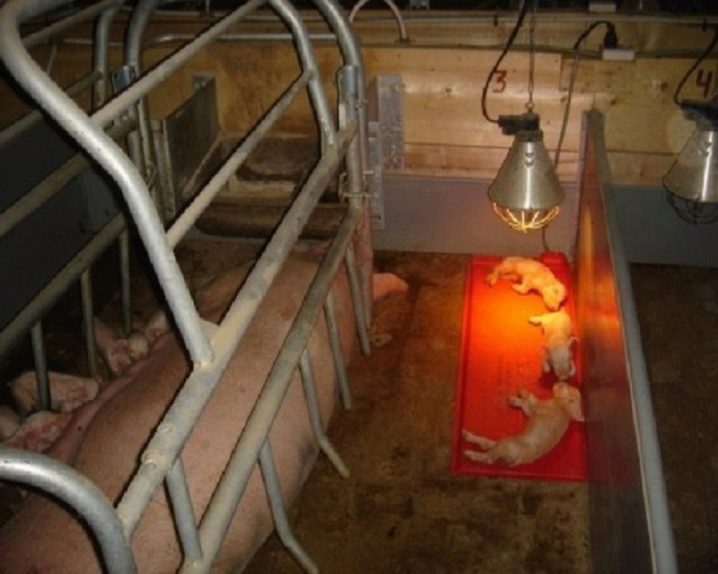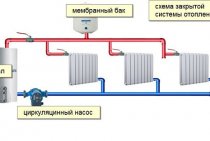When not to heat
To organize the heating of the chicken coop, two methods are used - artificial and natural. Each of them has its strengths and weaknesses, differing from others in energy consumption, efficiency and the amount of money spent. So, for regions located in southern or temperate latitudes, the natural method is quite suitable. The main condition for the application of this method is the absence of a significant decrease in night temperatures and strong winds. If the temperature in an unheated room can be kept within 7 degrees, then the natural method is more rational, and, when carrying out a number of heat-saving measures, it can be safely used.
The first object of warming the chicken coop is the floor. This is due to the fact that due to the plumage, the bird's body is not particularly sensitive to cold, and the legs are the only weak spot. That is why floor insulation should be done in the first place. Before proceeding with the laying of the insulation, the floor surface must be sprinkled with powdered slaked lime at the rate of 1 kg / m2. The presence of lime will save the chicken coop from the appearance of fleas and ticks. Then the lime layer is covered with any heat-insulating material, which can be used as sawdust, fallen leaves or straw. The total thickness of the layer should be 25-30 cm.
The most effective means of natural space heating is manure. In the process of overheating, the mullein releases a significant amount of heat, which is quite enough to “heat” the chicken coop during the winter. The only condition for the use of manure is a ban on the removal of old, already trampled mullein. In such cases, a layer of new fertilizer is laid on top, while retaining the previously laid manure.
After insulating the floor, it is necessary to proceed with the thermal insulation of the walls and ceiling. To do this, you need to plug all the cracks, not forgetting to form a small ventilation window. When building a chicken coop that is not equipped with artificial heating, double walls and a ceiling should be made. The cavities between the two surfaces are filled with polystyrene foam or mineral wool, and the thickness of the insulating layer must be at least 15 cm. chickens tolerate frosts up to 12 degrees. The final step in the insulation of the chicken coop will be the insulation of windows and doors, which is carried out using polyethylene or dense fabric.
Features of heating the chicken coop in winter
When breeding birds, their temperature preferences must be taken into account. This will help not only keep the chickens in good health, but also maintain their egg production in the winter season.
When caring for birds, the following temperature conditions must be considered:
- The temperature at which most chickens feel most favorable is 12-15 degrees Celsius.
- The minimum temperature in the room where the birds are placed is 10 degrees. When the temperature drops below this value, the likelihood of developing colds greatly increases. Feed consumption also increases, since the bird's body spends part of the energy received on its own heating.
- The highest indicator of egg production of chickens appears at 18 degrees.
If you are also breeding birds, then you need to know about the allowable temperature conditions for chickens. Until the first 21 days, birds need to maintain an ambient temperature of at least 21 degrees. In the future (up to 50 days), the temperature can be reduced to 16 degrees Celsius.
Important! Too hot air is also harmful to the health of birds. Violation of the temperature regime will entail a decrease in the number of eggs given, and in especially severe cases - the death of birds
Do chicken coops need to be insulated?
If you are seriously involved in breeding chickens, consider the air temperature at different times of the year. So, you will keep the birds healthy, and they will lay eggs all year round. Favorable temperature for a chicken is from 12 to 15 ° C, and at 18 ° C the bird rushes intensively. The temperature in the chicken coop should not be allowed to fall below 10 ° C: the birds will start to get sick, and the feed consumption will increase. In the cold, a living being spends vital energy to keep warm, so he needs more food.
On the first 21 days of the chickens' life, the temperature in the chicken coop should be at least 21 ° C, then it is gradually reduced to 16 ° C.
Avoid high temperatures. It can lead to overheating and death of birds.
Farmers recommendations
Experienced farmers offer beginners some tips on heating chicken coops. For instance:
- The fallen snow can be thrown on the walls and roof of the chicken coop from the outside. It will help keep the heat inside better. However, with the advent of spring, you need to recline it to avoid flooding the house.
- Ventilation windows are best made with double glazing. A large part of the heat will escape through a window with one glass.
- It is advisable to insulate the ventilation pipe with cotton wool. Through an uninsulated or improperly installed pipe, cold air will enter and warm air will leave. To avoid this, the gaps at the point where the pipe enters the ceiling and floor must be coated with a sealing compound. If the gaps are too large, they are laid with cubes of mineral wool.
- The ventilation pipe is equipped with a damper that will regulate the flow of incoming air.
- Windows must be sealed with rubber gaskets. Otherwise, the heat will begin to leave the room already at a temperature of -15 degrees. So, rubber seals for plastic windows are also applicable for warming wooden and glass windows in a chicken coop. Rubber bands are bought at a regular hardware store and glued with superglue.
- If you constantly go in and out of a heated chicken coop, it can be significantly cooled. Installing a vestibule door can correct this situation. It is enough to equip a heat-saving vestibule with an area of 0.5 sq. m.
Is it possible to do without electricity
An alternative to electric heaters are gas and stove heating systems traditional for our region. Each of them has its advantages, disadvantages and conditions for rational use, however, in any case, such space heating will help to cope with any sudden temperature drops.
Using a potbelly stove
An ordinary heating potbelly stove is the easiest way to heat a chicken coop, regardless of the climatic conditions of the region. This heating system consists of a metal combustion chamber (boiler) and a chimney. In the process of fuel combustion, heat is released, which heats the surrounding air through the walls of the potbelly stove.
Such a heating system is quite practical. It does not require additional costs for maintenance, and absolutely any non-toxic material can become fuel for it. However, building heating with a potbelly stove is not so simple. In addition to the boiler and the ventilation pipe, the system requires strict adherence to all fire safety standards, since the potbelly stove provides for heating with an almost open flame.
Benefits of a potbelly stove:
- cheapness;
- low fuel costs;
- practicality and ease of care;
- ease of installation of the heating system.
Potbelly Disadvantages:
- low fire safety;
- fuel must be thrown up independently;
- emits an unpleasant odor during operation.
We advise you to read how to keep such breeds of chickens: Loman Brown, Cochinchin, Sussex, Orpington, Minorca, Dominant, Black Bearded, Russian White, Faverolle, Andalusian, Wyandotte.
Heated chicken coop with gas
Heating with gas is the most efficient way to create the right temperature in the chicken coop. Gas heating system can be of two types: water and convector. Water is a chain of a boiler, heating elements and a system for removing combustible gases. During the combustion of fuel, heat is released, which is used to heat water.
Circulating through the system, the water gives off its heat to the batteries, which directly heat the room. Convector heating is a system of point heating elements - convectors. They function like electric convectors, however, the heating element is heated by gas combustion in a sealed chamber of the device.
Important! Gas heating is installed only in the case of a farm with at least several hundred chickens. For domestic purposes, such heating is an inappropriate waste of money.
Advantages of gas heating systems:
- rapid heating of the room;
- energy efficiency;
- high fire safety;
- absence of an unpleasant smell in the course of fuel combustion.
Disadvantages of gas heating systems:
- high cost of equipment;
- the need for constant monitoring of the serviceability of the gas supply system;
- high cost of fuel.
Heating a chicken coop is one of the most important processes in the care and breeding of poultry. Optimal climatic features for chickens throughout the year are the key to their good health and high egg production. This process must be approached as carefully as possible, as it directly affects the farm value of each individual on the farm. Therefore, the choice of the optimal heating system should take place not only on the basis of personal preferences, but also according to the effectiveness and expediency of the funds spent on it.
Chicken coop heating
For example, if the chicken coop is built close enough to the house, then the same method of heating can be used to heat it as heating the house - this is water heating. In this case, pipes should be laid. And when heating the house, the chicken coop will automatically be heated. The method is very convenient because ⦁ the air does not burn, as in other heating methods; ⦁ there is no need to constantly monitor compliance with safety regulations; ⦁ and there is no need to spend time heating the chicken coop, as it is heated at the same time as heating the house.
So, in this article, all methods have been described on how to heat a chicken coop in winter. The poultry house decides which method to choose, but the main thing to remember is that if the chicken coop is warm, the egg production will not change, but will remain at the same level. And the birds in a warm chicken coop will not only not get sick, but will honor themselves much more comfortably in the harsh winter.
Videos chicken coop heating in winter
Room insulation
Even high-quality do-it-yourself heating will not save you from the cold if frosty air enters through holes in the walls, doors and roof. Drafts significantly increase the cost of heating a room. Therefore, before installing any of the heating systems, it is advisable to spend a little money and start insulating the chicken coop, this will reduce costs in the future and provide a warm shelter for the birds.
Walls
There are many materials for insulation on sale, but most often poultry farmers use mineral wool. It retains heat well, does not let in cold, has high resistance to chemical, physical and biological factors, and it is also easy to install. Wooden or iron slats are installed on the walls, forming cells in which cotton wool is laid.Any vapor barrier material is attached from above, it will protect against the accumulation of condensate. The finishing material is attached last, you can use chipboard, USB or plasterboard sheets.
On a note!
Since mineral wool may contain some substances that adversely affect the health of birds, it is better to use it for external wall insulation.
Also, polyethylene foam is used as a heater, but its cost is quite high. It is better to choose a material with a foil coating, as it perfectly reflects heat. For mounting on walls, rails are nailed, on which the material is fixed with self-tapping screws. The joints are fastened together with a special adhesive tape on an aluminum basis. After the insulation is closed with trim.
The most economical way to insulate the walls in a chicken coop is to putty the walls with clay and sawdust. To achieve the desired result, it is imperative to observe the proportions of 3 to 2, 2 parts of sawdust are added to 3 parts of clay. Clay is pre-soaked in water, stirring until a homogeneous substance is formed, then sawdust is added to it and mixed thoroughly, it is better to use a concrete mixer for this. The resulting composition is applied to the wall with a three-centimeter layer. When drying, cracks often form, they need to be covered with the same composition. When the walls are dry, they are covered with quicklime.
floors
The floor plays a very important role in maintaining heat, if the chicken coop is built directly on the ground, then it will freeze through and, accordingly, it will be cold in the room. Most often, the same mineral wool, polystyrene foam is used to insulate the floor, and expanded clay also retains heat very well. A litter is placed on top of the coating for insulation; for this, sawdust or wood shavings are used. Many poultry farmers recommend buying sawdust from spruce, they have disinfectant properties and slow down the reproduction of pathogenic flora. A layer of straw is sprinkled over the bedding.
Ceiling
In areas with frosty winters, it is recommended to build chicken coops with a gable roof, this will reduce the load on the covering, and the attic will help retain heat. To insulate the roof, the same materials are used as for floor insulation.
Windows and doors
Equally important is the insulation of window and door openings, because cold air can penetrate through the holes in them. To begin with, they inspect the loot, if necessary, foam the cracks, and they also do the same with window frames. Then you can clean off the excess foam with a clerical knife and cover the area with putty. Rags can be placed in large holes. Thermal insulation materials are used for door upholstery.
Varieties of heating
In order to maintain the maximum egg production of chickens in winter, the birds need additional lighting and heat in the room. As for thoroughbred chickens, each variety has its own temperature standards in the chicken coop, but in no case should it fall below +10 degrees Celsius. Temperatures from +12 to +18 degrees will be comfortable for birds. Install a thermometer to monitor the temperature in the chicken coop. There are two types of heating:
- Natural.
- Artificial.
The first includes the insulation of the room itself and the laying of additional bedding, which, when exposed to natural processes, generates heat. Artificial heating is the installation of a heating system and electric heaters.
The need for heating
The creation of a favorable temperature regime is directly related to the productivity of chickens and is a necessary guarantee of successful farming. Even a slight decrease in temperature in the chicken coop, lasting for several days, can dramatically "drop" the egg production of the bird and significantly reduce the weight gain of broiler chickens. Heat acts as priority conditions for keeping, along with feeding and making the necessary top dressings.In addition, in a cold room, the risk of colds increases sharply and a noticeable decrease in immunity occurs, and when the temperature drops below 5 degrees, the bird can even develop arthritis in the legs. Also, a sharp drop in temperature in the chicken coop can cause the formation of frost and an increase in humidity, which inevitably leads to the occurrence of infectious diseases in broilers and laying hens.
However, keeping poultry at low temperatures affects not only the health of chickens. In addition to the fact that egg production drops sharply, there are problems with hatching chickens. This is due to the fact that the embryos do not have enough maternal warmth, as a result of which a very large percentage of unhatched chicks die. Due to the fact that most of the calories the bird has to spend not on gaining weight, but on heating its body, feed intake is almost doubled, which, along with a decrease in productivity, casts doubt on the feasibility of breeding chickens.
In winter, the optimum temperature in the chicken coop is considered to be 10-15 degrees Celsius. An increase or decrease in these values disrupts the biological rhythms of chickens and negatively affects their general condition. To constantly monitor the temperature in the chicken coop, hang two thermometers. One of them should be placed at the front door, and the second should be placed closer to the ceiling near the upper perch.
This is interesting: Beautiful houses: we consider in general terms
Is it possible to do without additional heating
In most cases, additional heating is the only way to provide the most optimal conditions for keeping chickens. This issue is especially acute for regions with a cold northern climate, since under such conditions, with a lack of heat, a bird can become seriously ill or even die.
But in a temperate climate and other, warmer climatic zones, the chicken coop does not require additional heating, since natural heating for these birds will be quite enough. To do this, you just need to provide chickens with high-calorie nutrition.
Important! Extruded polystyrene should not be used as insulation for a chicken coop. This material is not able to pass excess steam through its surface, which will lead to excessive humidity in the chicken coop.
But in order for the birds to feel comfortable, the chicken coop should be thoroughly insulated. To do this, all the cracks must be carefully caulked, leaving only a small ventilation hole. In addition, walls, floors and roofs require enhanced insulation. The walls and roof are made double, with a small cavity between the inner and outer parts of the structures. It is necessary to lay a heater (foam plastic, mineral wool, etc.) with a thickness of at least 10-15 cm in the cavity. The floor is also made double. On top of the main coating, it is necessary to lay an additional insulating ball with a thickness of at least 15 cm. For these purposes, peat, sawdust or straw will be most suitable.
As a result, the design of the insulated chicken coop should resemble a thermos. The heat released during the life of birds becomes the main source of creating a favorable temperature in the room, which, thanks to the insulation ball, remains for a long time. In this case, the insulated chicken coop allows the birds to safely withstand seasonal frosts down to -10-12 ° C.
We recommend that you familiarize yourself with the breeds of chickens: Hisex, Hubbard, Maran, Amrox, Master Gray.
How to heat a chicken coop in winter without electricity
The technology assumes that heating devices and electricity will not be used to heat the premises in winter. In the fall, you need to conduct a thorough inspection of the room where the chickens live. Seal up all holes, cracks, chips in the walls, it is advisable to caulk them for the winter.
If the bird is provided with full and sufficient nutrition, then it will be able to heat itself. Additionally, the walls of the chicken coop are sheathed from the inside with insulating material. The simplest option for insulation is polystyrene foam or mineral wool.
Take a thick layer of material and sheathe it so that there are no gaps between the sheets of insulation. The ceiling in the chicken coop is also sheathed with insulating material, and the doors and windows are decorated with rags.
Thus, you will be able to get rid of the draft and maintain the desired temperature in the room. The floor in the chicken coop is covered with a thick layer of bedding, it helps to keep the heat from below. Bedding should be poured at least 10 centimeters in thickness.
Bedding material is hay, peat, straw or sawdust. The litter is also convenient because in the spring it can be used as fertilizer for the garden. In winter, the bedding works as a natural heater.
The bottom line is that during the life of chickens, the litter is mixed with excrement and the composting process begins. During this process, heat is released, it lingers in the room and can provide an air temperature of up to 12 degrees Celsius.
Periodically, the litter should be turned up and a layer of fresh material added. Until spring, up to 25 centimeters of compost can collect in the chicken coop. Before preparing the bedding in the chicken coop, the floor in the room is treated with slaked lime.
The proportion of the material is 1 kilogram of lime per 1 square meter. Lime helps the composting process and disinfects the room. When exposed to heat, it kills bacteria. For a normal microclimate in the chicken coop, ventilation must be adjusted.
If it works poorly, or does not work at all, then a persistent smell of ammonia will appear in the air. It is harmful not only to birds, but also to humans. The ventilation hatch is opened several times a day for ventilation, and then closed.
Heat also escapes through ventilation, and if you do not use heating appliances, then you need to regulate the flow of fresh air.
This method of warming may be suitable for regions where the winter is warm. In the northern regions of the country, drastic measures will be needed to heat the premises.
How to do without electricity
The artificial method of heating requires the use of heating equipment, the choice of which depends on external temperatures, the size of the room and the financial capabilities of the farmer. Electric, gas and solid fuel appliances are used to heat flocks and chicken coops. The simplest is the electric heating method, however, with frequent power outages or with constant power surges in the network, it is better to refuse this heating method and use others.
Burn with gas
There are two types of gas heating: convector and water. The water system works according to the following principle: the heat generated during the combustion of gas heats the water in the heat exchanger to the desired temperature, after which the coolant, moving through the pipes and entering the radiators, heats the room. The essence of convector heating is that the device is devoid of pipes and has no connection with radiators, it heats up exclusively by itself, and outwardly resembles a large electric heater. Among the advantages of gas heating can be noted the possibility of rapid heating of the chicken coop and high energy efficiency.
The disadvantages include the high cost of equipment and the need for constant human presence. In addition, when installing a gas boiler, you will need permission from the gas services and strict compliance of the building with fire safety standards. It is advisable to use this type of boiler equipment in large poultry farms, where constant monitoring of the device and its maintenance will be carried out.
potbelly stove
Heating with metal stoves is the simplest and most affordable way to heat chicken coops. The potbelly stove is distinguished by a simple device, does not need expensive maintenance and regular maintenance. The essence of the work of the potbelly stove is quite simple: when solid fuel is burned, the metal walls of the stove become hot and begin to give off their heat to the room. The advantages of this method are the low cost of fuel, quick installation and ease of use.
The disadvantages include the need to comply with fire safety rules, which obliges to carry out a set of measures aimed at preventing a fire. Such measures include the construction of a fireproof pallet and the protection of nearby wooden walls from high temperatures. In addition, the use of a potbelly stove requires the constant presence of a person, which is due to the need to constantly add fuel. But the most significant disadvantage of heating with a potbelly stove is that it will not be possible to maintain a constant temperature in the room.
Diesel oven
Heating with diesel appliances is also used for heating chicken coops. Such installations are able to quickly warm up the air in the room and, unlike bourgeois stoves, have a temperature regulator. This allows you to change the intensity of the flame burning and create the required temperature in the room. Diesel plants are completely fireproof and environmentally friendly. The disadvantage of such systems is the high cost of diesel fuel, which most likely will not cover the profit received from the sale of chickens.
Buleryan
This type of oven belongs to air-convection and is a good solution to the problem of heating chicken coops. The devices are characterized by high energy efficiency and can operate on any fuel. In addition, buleryans, like all convection models, are quite economical and have high power. This allows you to use them for heating large-scale chicken coops of subsidiary farms and farms.
Water heating
The water heating method is considered the most efficient and fireproof. If the dwelling is heated with a water-heating boiler, then the ideal option would be to connect the chicken coop to the heating circuit of the residential building. To avoid heat loss during transportation of the coolant from the house to the chicken coop, it is better to build a room for keeping chickens right next to the house. In the case of a remote location of buildings, pipes running along the street should be insulated.
